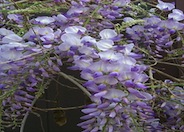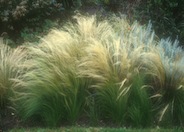
Common name:Chinese Wisteria
Botanical name:Wisteria sinensis
While the sinensis is similar to the floribunda, it bears more rounded, full clusters of strongly fragrant flowers which open more or less, all at once. There are usually 13-15 leaflets per leaf, and they require full sun and average to little watering. It comes in many colors in the blues, whites and purples.-Monterey Bay Nursery

Common name:Shrub Rose
Botanical name:Rosa Shrub varieties
The dark green, heavily veined leaves of this bushy shrub are strong support for the pure white or pink, nearly double flowers it produces. This is a very tolerant, heavily scented plant with an impressive fall color. Also, large hips appear intermittently with this plant.

Common name:Mexican Feather Grass
Botanical name:Nassella tenuissima
This ornamental grass grows to 2' tall. It goes partially dormant during the summer but green in spring and fall. It prefers a sunny, well drained site. This plant can be invasive in some areas, so use caution. To keep reseeding to a minimum, drip irrigation will be best. Cut back in early spring to remove dormant foliage and dried seed heads. It can also tolerate dry shade. It grows to 10" wide and is the finest textured of the ornamental grasses.

Common name:Eulalia Grass, Silberspinne
Botanical name:Miscanthus sinensis 'Silberspinne'
These deciduous grasses grow from 4'-7' tall, and often turn orange or dark red before going dormant. Tall, showy spikes of feathery, curved seed heads are borne and retained well into the winter or the following spring. It should receive sun to part shade, and average to little summer watering. Tall grasses are highly combustible. -Monterey Bay Nursery

Common name:Rock Purslane
Botanical name:Cistanthe grandiflora
This perennial will grow 12"-36" and produces large blue-green rosettes that last for a long season. It produces large, silky, lavender pink flowers that have lime-green, purple spotted calyces.
| Designer: Amelia Lima Design | Peace and Harmony |
Photographer: GardenSoft |
Soils and Compost:
Practice grass-cycling by leaving short grass clippings on lawns after mowing, so that nutrients and organic matter are returned to the soil.
Water Saving Tip:
Integrated Pest Management:
Remove irrigation water and fertilizer from areas where you don't want weeds to grow.

